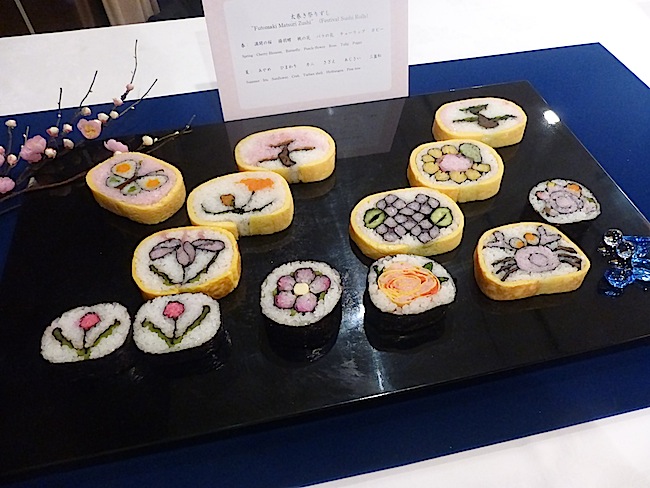
We recently had the opportunity to attend the delightful reception “Celebrating Worldwide Recognition of Washoku and Rice” aimed to present the appeal of rice and its importance in Japanese cuisine (washoku). In our first article covering the event, we gave you a round-up on the talks and demonstrations made by three guest speakers during the first part of the evening’s program, including the serving of a traditional Japanese meal prepared by a master chef. Now, it was time for us to get active and try our hand at a bit of sushi rolling!
In this, the second and final article in this two-part series, we’ll attempt to create a special futomaki sushi roll known as Futomaki Matsurizushi (“thick roll festival sushi”) like the one made by Ms. Eiko Ryuzaki, president of the Chiba Traditional Local Cooking Study Group, in one of the presentations earlier that evening.
Okay, so we weren’t going to be able to create an entire plate of colorful festive futomaki rolls like the display in the picture above, but we were excited about the chance to make even just one pretty little roll! So, were we ready to get our hands sticky with rice? You can bet we were!
Those of us participating in the futomaki making experience were divided into small groups at several tables, with a sushi roll instructor at each table, so we were sure to have expert guidance (which we were sure we would need).
▼When we got to our table, the bamboo mats for rolling the sushi and all the ingredients were neatly laid out for us, including the pink and white vinegared rice. So yes, we had it kind of easy to start with.
▼First we divided the pink rice into five equal portions …
▼… so that we can place it evenly on top of the strip of nori seaweed. There’s a powdered mix available, by the way, that you can easily mix with plain cooked rice to make pink vinegared rice.
▼We then placed a smaller amount of white rice on top of the pink rice and mixed them together evenly.
▼We rolled the rice and seaweed together, rolling the bamboo mat firmly between the palm of both of our hands …
▼… and we repeated the process to make five identical thin rolls (well, some were slightly thicker than others in our case, but in theory, the rolls were supposed to be identical).
▼We then placed pieces of processed cheese in the center of the five rolls, while holding everything on the bamboo mat together in one hand.
▼We also placed long, thin pieces of boiled spinach between each of the rolls. That completes the first part of the futomaki.
▼We then moved on to the second part of the roll, beginning with a fresh sheet of seaweed, onto which we placed plenty of white vinegared rice.
▼The cluster of five thin rolls we made first was then placed inside the large sheet of seaweed and white rice.
▼We made sure the white rice went evenly around the five central rolls.
▼We then firmly rolled everything together into shape.
▼Now all we had to do was cut the roll.
▼Our instructor actually took care of this part, as it can be somewhat difficult to cleanly cut a roll of rice.
▼And here we have part of the completed futomaki — in the pattern of peach flowers! If you saw our first article, this is the same type of roll as the second futomaki Ms. Ryuzaki made in her demonstration earlier that evening.
▼And here’s all of the sushi roll, cut into seven pieces. We were worried about whether we would be able to make a decent looking roll, but we have to say, it turned out better than we had expected (although we had the expert help of our instructor to thank for that). The pink rice gives it such a gentle yet pretty tinge of color!
▼Now, after all that rolling, we were ready to taste a bit of the sake they were giving out at another table.
▼They had two types of the Dassai junmai daiginjo sake (pure rice ultra-premium sake) , the Dassai 23 and Dassai 50.
Junmai daiginjo sake, which is generally considered to be the highest class of sake, is made using only water, koji rice malt and rice, and the rice specifically has to be polished enough to remove at least 50% of the original grain for the sake to be classified a daiginjo. The Dassai 50 is a junmai daiginjyo sake made from rice polished down to 50% of its original size, and the Dassai 23 from rice polished down to 23%. We sampled the Dassai 23, and it was incredibly mild and smooth but not overly sweet.
▼Not surprisingly, people were eager to give the drink a try.
All right, after the informative talks and demonstrations, enjoying a Japanese meal consisting of one soup and three dishes plus beautifully cooked rice, rolling some sushi and tasting a bit of sake, we have to say we were quite happy!
We certainly hope many people around the world have the chance to enjoy fine washoku and sake, whether at a local Japanese restaurant or on a visit to Japan. And the next time you have the chance to have a Japanese meal, perhaps you can keep in mind that while there are many styles and different kinds of Japanese cuisine, one thing that remains a constant is that rice plays a central role. You could very well say that without rice, there is no Japanese cuisine. So here’s to rice, that wonderful grain that is not only a crucial part of our diet but gives us so much pleasure as well — yes, we love you, rice, and we couldn’t live without you!
Photos: RocketNews24